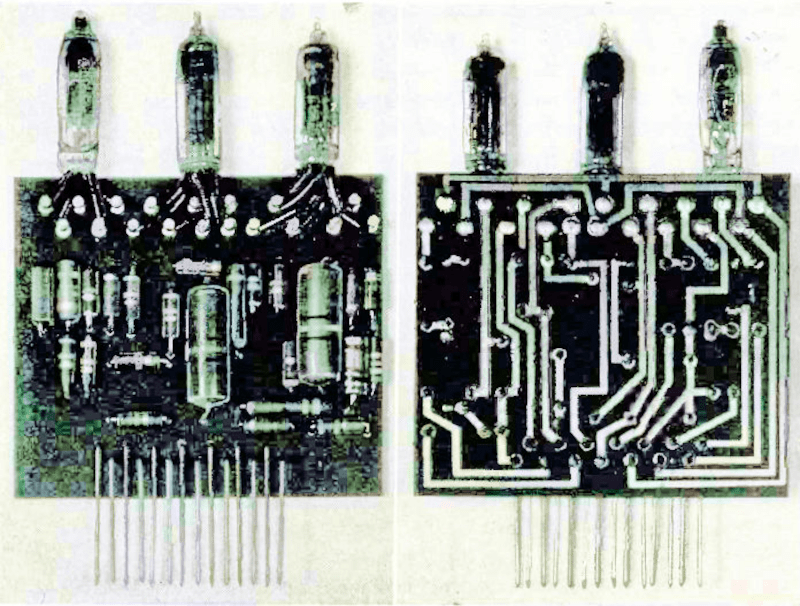These days, it is hard to imagine electronics without printed circuit boards. They are literally in everything. While making PCBs at home used to be a chore, these days, you design on a computer, click a button, and they show up in the mail. But if you go back far enough, there were no PC boards. Where did they come from? That’s the question posed by [Steven Leibson] who did some investigating into the topic.
There were many false starts at building things like PCBs using wires glued to substrates or conductive inks. However, it wasn’t until World War II that mass production of PC boards became common. In particular, they were the perfect solution for proximity fuzes in artillery shells.
The environment for these fuzes is harsh. You literally fire them out of a cannon, and they can feel up to 20,000 Gs of acceleration. That will turn most electronic circuits into mush.
The answer was to print silver-bearing ink on a ceramic substrate. These boards contained tubes, which also needed special care. Two PCBs would often have components mounted vertically in a “cordwood” configuration.
From there, of course, things progressed rapidly. We’ve actually looked at the proximity fuze before. Not to mention cordwood.
















Some of the Automotive Electronics from the 1990s were using the silver traces on a ceramic substrate. It was potted in a thick, transparent goo. If I remember right is was an integrated voltage regulator on an early 90’s Chevy.
I remember the same on a 90 Plymouth Colt. Was my first introduction to unrepairable components.
Geez, my ’73 Fury had the newfangled “electronic ignition” potted in silicone goo. It quit one day. You *can* repair them, with sufficient determination. The failed component was a TO-3 transistor that was just floating in the goo: no heatsink. Like, WTF?
Brought its leads outside to a replacement TO-3 transistor, this one heatsinked. It lasted for years after that.
Ford’s EDIS ignition controllers were like this too – the potting goo was water clear and squishy, we never found a commercially available version.
And those suckers were reliable too – I’m still running Megasquirt & EDIS on my vehicles today.
I remember reading about this in an old zine or encyclopedia when the article could not show what they were using them for. It was still secret.
Cordwood… wonder where they went? With modern electronics, parts are so small plus multi-layer PCB means cordwood designing and assembly is impractical.
its also a pita to work on. at a time when rework was almost essential.
PCBs aren’t always that great, though.
Especially in radio circuits, a more “3D” wiring style approach can be a benefit.
So it’s not like the old school criss-cross wiring is totally obsolete.
There are moments in time were and older technique has its advantages.
What’s also not to be for forgotten, before PCBs had been around it was possible to perform “clean” pr moduoar wiring through use of soldering strips and similar constructions (some had screws).
Remember ‘tag strips’ They were fun.
As I know Mr. Paul Eisler from Austria was the inventor of the PCB.
https://ats.net/paul-eisler-erfinder-der-leiterplatte/
Wire Wrapping was considured to be much more reliable than solding. IBM, DEC, GE, etc all used WW in their backplanes because “wire wrap creates a ‘gas tight’ connection at four points on each turn.” and was found to be more reliable than solding long term.
Why not both?
Because extensive testing by the military showed that soldering a wire wrap connection DECREASES the reliability. And adds weight and makes rework almost impossible.
I had a friend whose dad was a sapper in WW2, died 10 years before my time but left stories about opening unexploded parachute mines dropped on Londen, and finding what seemed to be card stock with conductive lines drawn on them, squished together into flat packs with tubes connected to them.
There’s an old book about the sappers too, used to be well-known in the 80s, that talks about the shadow war between the sappers trying to disarm bombs and the German engineers trying to make them infallible. Discovering new and incredible technology, for the time, with just about every job.
We really don’t adequately appreciate the fighters who got the western world into peace. Today chaos wants to drag us down, back then the enemy was basically us.
There was a story in an old BBC documentary about a new type of German mine that washed up on the shore and the guys that went out to defuse it & analyse it, and they re-created it with existing recruits from the bomb disposal team in Portsmouth docks and the actual mine and original tools that they’d kept in their HQ for training ever since.
I can’t imagine the balls it takes to crawl out across a mud flat to a floating bomb and just have a go at taking it apart with no information on how it works at all.
I remember when Zenith (the television company) advertised about their “point to point” wired chassis (terminal strips), when most other TV manufacturers were beginning/already using PCB boards.
Several years later a TV repairman, told me running a soldering gun down those same straps fixed a lot of intermittent connections.
“I remember when…”
Exiting new hardware platforms appear daily?
Porting software running on yesterday platform issue.
Hardware platforms now built from software by different vendors
– Tensilica, Cadence .. in addition to ARM and RISC-V, of course?
And require updates as fast as software?
Reason to learn gcc c transparent portable software technology?
The article is very abridged version of PCB history and kinda jumps from simple screen printed pcb to JLCPCB. There were much more variety around that time. Wirewrapping was a thing for aviation electronics etc.